The Franconian Conquest, East-Franconia and
the settlement of the Upper Main area
When, after the fall of Rome, the tribal association of the Franks set off from the Lower Rhine, the so-called Franconian Conquest, to first defeat Gaul, they also turn eastwards for taking the Thuringian Empire in 531, whereupon further Frankish troops force until the 9th century. The natural border of the Fichtelgebirge (mountains) and the Upper Main area (river Main), and even today’s ”Franconian Switzerland” are to be annexed under the leadership of the Higher Nobles of the Walpots[1] and the contrary, Slavs from Bohemia arrive in small groups and settle in irregular chronological order both the Upper Palatinate and Upper Franconia[2] – many place names suggest Slavic references[3].

The Franconian imperial palace of Forchheim, where the “first German king” or better to say, the king of East-Franconia, Conrad I (881 – 918), is elected in 911, is a busy trading center and customs station between the Franks and the Slavs – already set up from Charlemagne.
The former district administrator of Neustadt upon Aisch, Heinz Kuehlwein, gives the following assessment:
“The (West) Franks did not invade (East) Franconia in massively huge troops, as the older local historians always liked to portray. It is now considered certain that a comprehensive and tightly organized takeover of our country cannot be assumed, because the number of Franks was far too small for that. Apparently, a special Germanic, probably partly Alamannic, partly Thuringian and also Slavic pre-population that already existed here, was simply overlaid in order to integrate East-Franconia more firmly into the Frankish realm so that the early Carolingians have more control”[4].
The East-Franks and Slavs subordinate to a Frankish count (comes) have the same legal status, including tax payments[5].
Presumably the later Frankish Gentry emerged of the former Frankish vassals and Slavic peasants (Czech: Vladyks), which is probably completed by the 12th century. At the turn or in the middle of this century, the “first nominations” of various knightly families start, such as the Gottsman of Thurn around 1042, the Rabenstein around 1188 or the Schenk of Siemau in 1195[6].
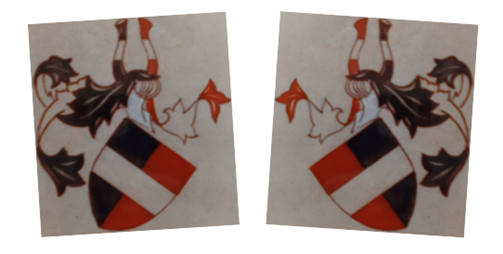
Lochner of Loch near Hollfeld in Franconia before 1300 A.D.
Herman I Lochner from 1274 A.D., first secured for the Lochner of Loch near Hollfeld[7] in the Wiesent valley, is found as the last witness in a series of milites (knights) at a donation from the Counts of Truhendingen. As the higher nobility of Andechs-Merania die out in 1248, their heirs become the Burgraves of Nuremberg (who receive the later Margraviate of Bayreuth) and the Counts of Orlamuende (inherit the dominion of Plassenburg-Kulmbach) as well as the Counts of Truhendingen. Furthermore, Boppo Lochner lives at the same time, who also acts as a witness for the Counts of Orlamuende[8] in 1284 and when Castle Zwernitz has been sold from the former Walpots to their brothers-in-law, the Burgraves of Nuremberg in 1290, Boppo Lochner is a witness again, just like on May 2, 1290[9] when the purchase agreement is sealed by King Rudolf. Boppo almost certainly has a wife named Jutta and they raise their sons Wolfram, Gottfried and Berthold, living in the village of Uetzing at those times (Staffelstein district) in 1306[10].
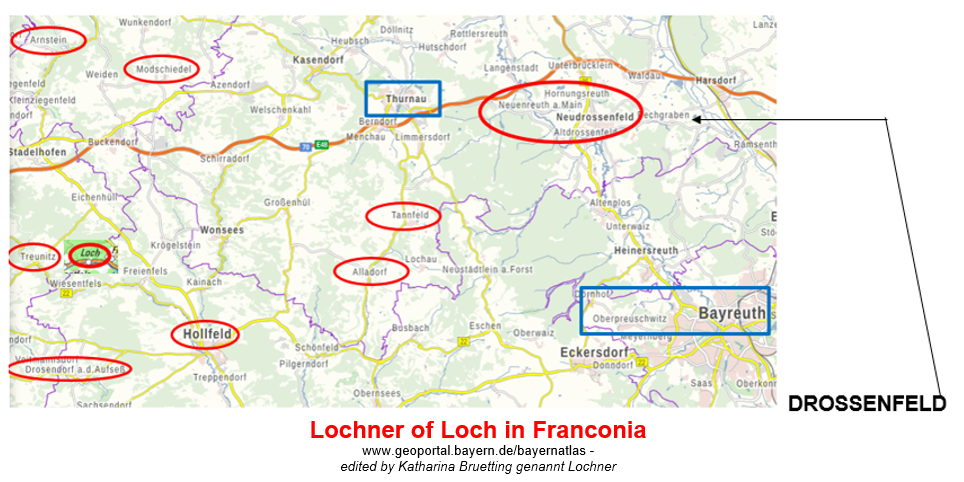
And he seems to have acquired the castle estate in Drossenfeld (today Neudrossenfeld near Kulmbach) between 1270 and 1290, which shows that he and his sons perform their service as knights for the feudal lord of the nearby Plassenburg, the Counts of Orlamuende (and after that sale, for the Burgraves of Nuremberg and the later Margraves of Bayreuth).
At this point in time, the family members call themselves “Lochner of Loch”, even Frederick II Lochner, who has emigrated to Bohemia around 1500, still uses this name in the first documents, which slowly changed into “Lochner of Palitz” (in the Cheb district in Czech Republic). Since the Lochner coat-of-arms also bears the so-called “tournament medal”, the knight Philipp Lochner could actually have jousted at the tournament in Zurich in 1165[11].
The Lochner family is named as the first owners in Drossenfeld, and a description from 1786[12] states, “…Drossenfeld Castle was an ‚open house‘[13] belonging to the Dukes of Merania and that since 400 years.” In the fief-book of Burgrave John III of Nuremberg in 1398, it is recorded that at this time the Lochners „… had a manor near Drossenfeld, as well as 18 acres of land as a fief“ – „… just as Boppo Lochner has called it his own“[14].
The above-mentioned sons of Boppo Lochner are to be seen as direct ancestors of the nowadays Barons Lochner of Huettenbach (from 1528 on), as well as of the Bohemian Lochner of Palitz (~1445 – 1700) and the Lochner of Nankendorf, who have existed until ~1700. This can be easily deduced from their exactly same coat-of-arms‘ variant from the first two mentioned lines of the Lochners (friendly tip from the recently deceased Franconian heraldry expert Eugen Schoeler).
More precise genealogical statements between 1300 and 1400 cannot occur because no documents exist. The lines start again around 1400 with Werner I, John I and Conrad I Lochner of Weiher (later on the Barons Lochner of Huettenbach), and – for the later Palitz’ Lochners, Herman II Lochner of Drossenfeld, and John II Lochner for Nankendorf, these lines will continue („red lines“ – see enclosure: Abbreviations of each Lochner-branch).
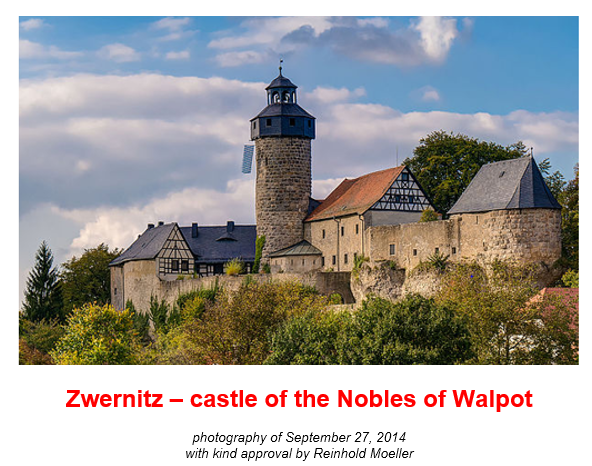
Another Lochner who is stated in 1306 is Arnold Lochner, possibly the brother of Boppo[15], having sold the fiefdom of the village Maehrenhuell to Langheim Monastery, which already serves as a burial place for the Andechs-Meranians, as well as for the Counts of Truhendingen and those of Orlamuende. His presumed descendants Louis and Ulrich Lochner[16] maybe the ancestors of the Lochner of Ebermannstadt (from ~1330 on) and the Lochner of Waischenfeld (from ~1400 on), respectively, and thus their Carinthian cadet line of the Lochner of Liebenfels (~1440 – 1570 – „blue lines“ – see enclosure: Abbreviations of each Lochner-branch). Sometimes the Lochners are seen as a side line of the Gross of Trockau (they also exist until today).
Castle Loch near Hollfeld in Franconia – a tower hill castle –
the „Lochnergrounds“
“In the early 9th century, the Franconian colonization already covered the Upper Main Valley. Initially, this advance into the dense forests had the character of a military colonization with the establishment of permanent bases. Preference was given to places that offered natural protection and – at the same time – a good view over the country”[17].
In this context, it can be determined that the Lochners settle on the upper reaches of the river Wiesent (today’s village of Loch near Hollfeld is located directly on the road B22 between Bamberg and Bayreuth, where one can find the plateau of the ‘Hoher Knock’ (= High Knock) above the village). There is a wonderfully wide view over the valley, ideal for building and defending a castle, which certainly corresponds to the type of a tower hill castle (see below) around the time of the Franconian Conquest. Also from the La Tène period of the Celts, rests of a fortress survived. The so-called ‘Lochnergrounds’ are a geographical landmark that stretches between the villages of Neidenstein and Weiher near Hollfeld. In Loch names of lanes are preserved like ‘Burggasse’ (= ‘lane-castle’) and ‘Turmholz’ (= ‘tower woods’).
“And a legend says that even today the clinking of the well chains with which the water buckets are brought to the former castle and were raised to the ‚Hoher Knock‘, are to be heard”[18]
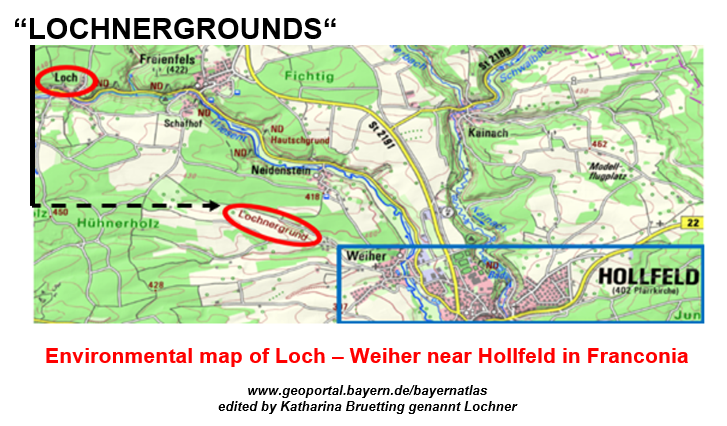
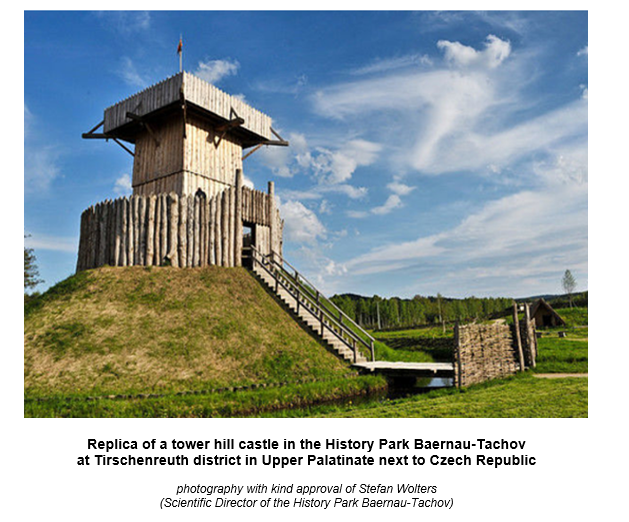
According to Klaus Schwarz[19] and Björn-Uwe Abels[20], the Celtic section fortifications on the Hoher Knock are built over in the Middle Ages:
“The ruins of Castle Loch near Hollfeld: to the northeast, through an almost completely demolished section of wall with a ditch in front secured complex, with remains of ramparts and ditches (early La Tène period finds) – geographical location: 49.9595 – 11.24003 degrees”[21].
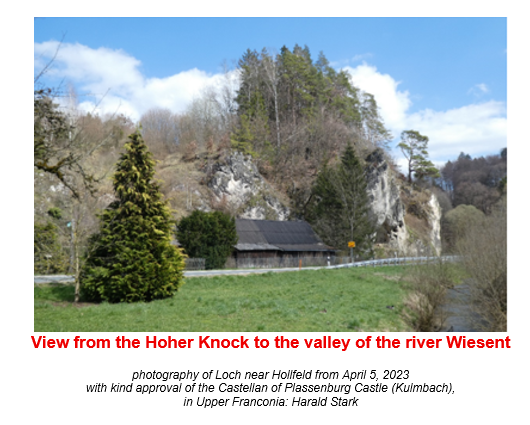
“The Lochner Castle could be reached via Weiher (near Hollfeld) and the ‘Lochnergrounds’ on a medieval route, which stretched south of the river Wiesent on the plateau“[22]

The term „knights“ – feudalism, allod and the transition from vassalage to gentry (lower nobility)
Cord Ulrichs talks about this in his book: “From fiefdom to Imperial Knighthood” on page 23, “…this knighthood as a profession included all knightly fighting warriors, whether free vassals or unfree ones. At the transition to the late Middle Ages, however, the vassals shed the characteristics of bondage and thus placed themselves legally on an equal footing with the old noble freemen. At the same time, as the knightly ideal faded, the unifying force between the social origins of different members of this class was lost. The old free nobility now emphasized their free origins again and became the class of counts and lords. In return, among the lower nobility – the former vassals – “to be knightly born” (= German: ‘Ritterbuertigkeit’) became the decisive characteristic”[23].
“To be knightly born” (= German: ‘Ritterbuertigkeit’) means descent from (lower) noble ancestors (“born to coat-of-arms”), which is usually the prerequisite for obtaining knighthood.

As a result, these vassals develop into warriors as a profession. They have to be “ready immediately for active combat in the event of a threat” – and who, to this day, have always received the greatest attention from society:
the fascinating world of knights.
They are subordinates to a feudal lord to whom they provide loyalty and allegiance and in return receive their fiefdom, i.e. the vassal is granted rights over land and goods for life. From 1062 onwards, the diocese of Bamberg had its own civil code of vassalage, which resulted in a “hereditary legal status”[24].
In this way, a feudal lord can bind several knightly families to himself, but some of them also have free property (= the Allod) – in this case the knights are free to decide what they want to do with their possessions. In these characteristics, the allod differs from the feudal estate, which does not belong to the tenant without restriction. The upper ownership of the fief remains with the feudal lord, who can demand various services from his vassals, usually determined by customary law. Fiefdom was so-called usable property, while allod was full property[25].
However, to become members of the lower nobility in Franconia is denied for many vassal-families, such as the Stuebig, the Fellendorfs, the Drosendorfs, Tuerkelsteins or Leinleiterers. They are absorbed into the bourgeoisie of the cities or into peasantry.
The German historian Werner Hechberger writes about this phenomenon: “…the development was very different within a family (of vassals) and its (several) branches”. Unfortunately, the high child mortality rate, rampant epidemics such as the plague during these times and, of course, the turmoil of the 30 Years‘ War made their sad contribution to this as well[26].
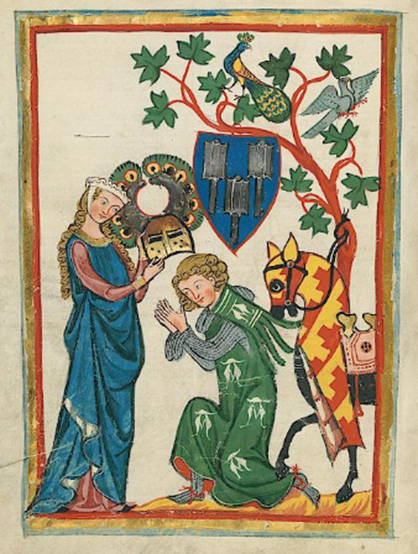
Chevalier Schenk of Limpurg
University Library of Heidelberg, Germany
Cod. Pal. germ. 848
Codex Manesse
(Zurich ~1300 to ~1340)
-public domain-
L I T E R A T U R E
(in German language)

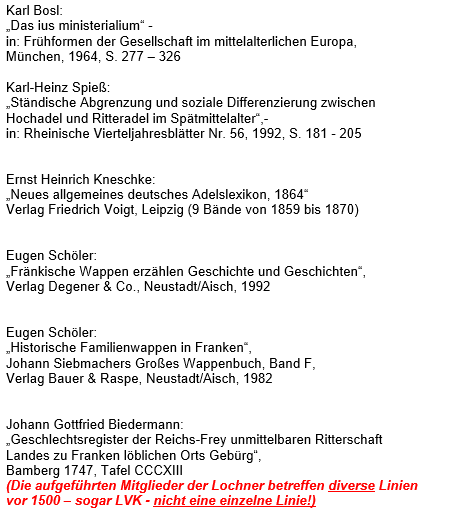
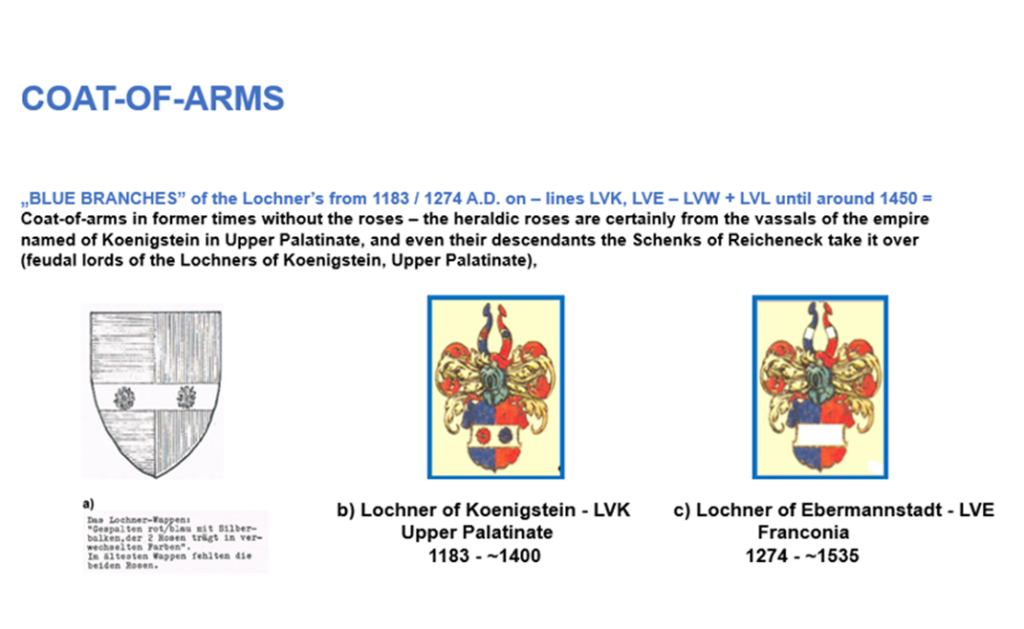
A t t e n t i o n:
probably the line of the Lochner of the free imperial city of Eger (LVEL) are a side-line of LVK
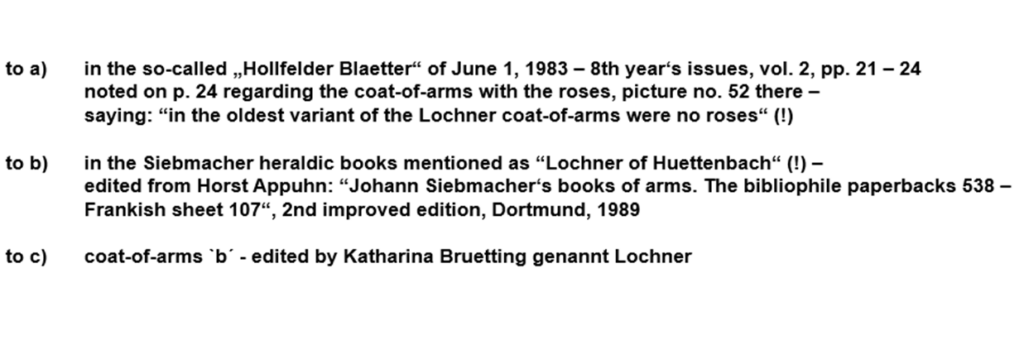
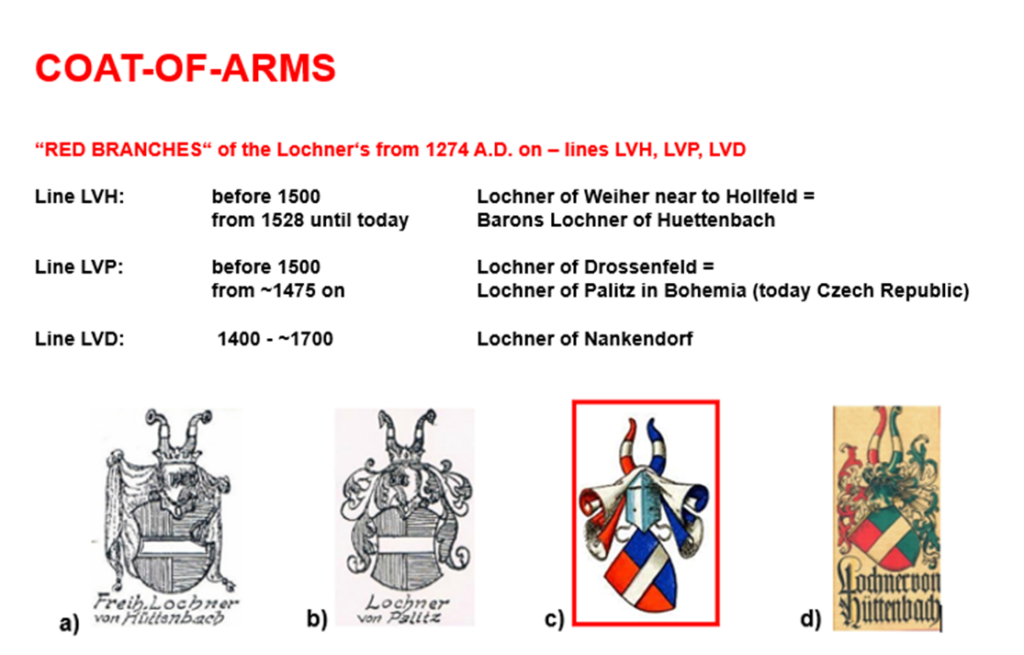
A t t e n t i o n:
the branch of the Lochner of the free imperial city of Nuremberg (LVN) are of the same origin
as Lochner of Palitz (LVP) named Lochner of Drossenfeld before 1500
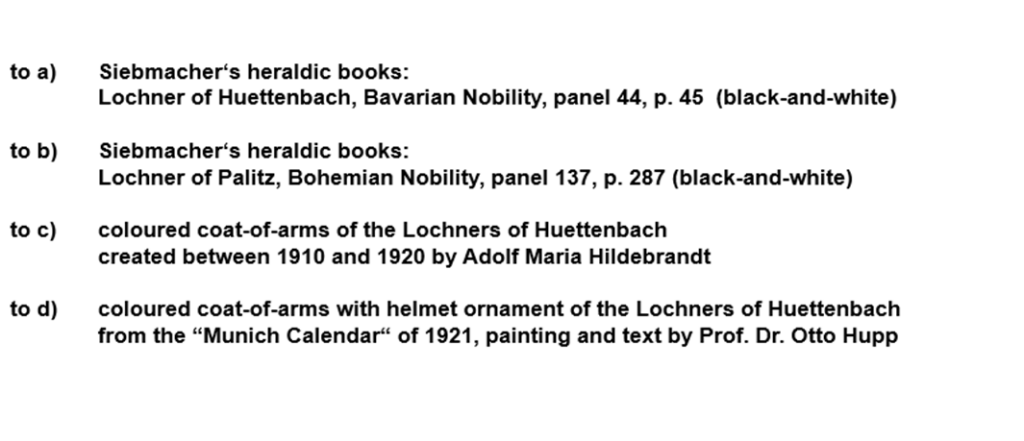


FOOTNOTES:
the books mentioned are in German language but the title of the books – as footnotes – are translated for a better understanding
-
Gustav Voit: „The Walpots“ – Palm & Enke, Erlangen and Jena, 1996 ↑
-
Hans Losert: „The Slavic settlement of Northeast Bavaria from an archaeological point of view“; Karl Schmotz (Editor): Lectures at the 11th Lower Bavarian Archaeological Day, Deggendorf, 1993 ↑
-
Michael Steinbacher: www.fränkischeswendland.de (www.franconianslavicland.de) ↑
-
Heinz Kühlwein: “Considerations on the early history of Gutenstetten”, highlights from the local history, Neustadt an der Aisch, 2002, vol. 26, pp. 3 – 32 ↑
-
Citation from Hans Losert: Lecture on the occasion of awarding the 2006 Archeology Prize by the Society for Archeology in Bavaria e.V. ↑
-
List of the Frank knightly families (in German language) – https://de.wikipedia.org/wiki/Liste_fränkischer_Rittergeschlechter ↑
-
StA BA Bamberg documents MA 1993 no. 875 – (StA BA = State Archives of Bamberg) ↑
-
Main State Archives, Munich, no. 980 – Johann Looshorn: ”The history of the diocese of Bamberg”, vol. 2, Munich, 1888 ↑
-
R. Stillfried/T. von Märker: „Monumenta Zollerana, document book of the House of Hohenzollern“, Berlin, 1852ff. ↑
-
StA BA Bamberg documents MA 1993 no. 1379 ↑
-
only mentioned in the genealogical reference works of John Gotfried Biedermann (see literature) – Line affiliation cannot be determined ↑
-
State Archives of Bamberg, Coll. Wipprechtanea, p. 113 ↑
-
‚Open house‘ = fortified seat of a family, i.e. it corresponds to an allod that is made accessible („open“) to a higher-ranking feudal lord, e.g. for military use (= “waited”) – by Eckard Lullies: “The feud of the Guttenbergs against the bailiffs and the feud of the nobility against Cheb”, series of publications “The Plassenburg” for local research and cultural preservation in East-Franconia, Friends of the Plassenburg e.V., vol. 50 (Glossar XXVIII) ↑
-
Martin Riedelbauch: „Castle and knightly estate of Drossenfeld“, p. 5 – Archives for the history of Upper Franconia, vol. 53, Publisher: Historical association for Upper Franconia, Bayreuth, 1973 ↑
-
StA BA Bamberg documents MA 1993 no. 1379 ↑
-
StA BA Bamberg documents MA 1993 no. 1606 ↑
-
Martin Riedelbauch: „Castle and knightly estate of Drossenfeld“, p. 5 – Archives for the history of Upper Franconia, vol. 53, Publishers: Historical association for Upper Franconia, Bayreuth, 1973 ↑
-
Heinz Buettner: “ Myths and legends from Franconian Switzerland“, Publishers Palm & Enke, Erlangen und Jena, 1994, p. 232 ↑
-
Klaus Schwarz: “The prehistoric and early historical site monuments of Upper Franconia“, Material booklets on Bavarian prehistory, vol. 5, Lassleben Publishers, Kallmuenz, 1955 ↑
-
Bjoern-Uwe Abels, Walter Sage, Christian Zuechner: “Upper Franconia in prehistoric and early historical times“, Bamberg, 1996 – La Tène period from 450 B.C. to 15 B.C. ↑
-
www.alleburgen.de – Rainer Hofmann: “Franconian Switzerland“, a guide to archaeological monuments in Germany, Stuttgart, 1990 ↑
-
Hellmut Kunstmann: “Castles of Northwestern and Northern Franconian Switzerland”, publication by the society for Franconian History, Series IX, vol. 28, Part 2, Wuerzburg, 1972, p. 138f ↑
-
compare to Karl Bosl: “ius ministerialium”, p. 312, and Karl-Heinz Spiess: “Demarcation”, pp. 189 – 191 ↑
-
In the Bamberg service law of 1062, the local vassals were given passive supremacy from birth, their own place of jurisdiction and privilege of evidence, honorary privileges such as carrying arms, the ability to be ordained and were given tasks in higher court offices – compare to Knut Schulz: “Ministerialitaet, Ministerialen” („Vassalage, Vassals“), in: Lexicon of the Middle Ages ( LexMA), vol. 6, Publishers Artemis & Winkler, Munich/Zurich, 1993, col. 638 ↑
-
Karl Heinz Burmeister: “Allod”, in Lexicon of the Middle Ages (LexMA), vol. 1, Publishers Artemis & Winkler, Munich/Zurich, 1980, col. 440f ↑
-
Werner Hechberger: „Adel, Ministerialität und Rittertum“, Enzyklopädie Deutscher Geschichte, Band 72, Oldenbourg Verlag, 2004, S. 114 =
Werner Hechberger: “Nobility, vassalage and chivalry”, Encyclopedia of German History, vol. 72, Publishers Oldenbourg, 2004, p. 114 ↑